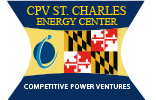
Frequently Asked Questions
The CPV St. Charles Energy Center (CPV St. Charles) is a highly efficient, 745-MW technologically advanced combined-cycle natural gas electric generating facility. The facility is in Charles County, Maryland, on land zoned for industrial use, and sits next to a landfill and an asphalt plant.
A combined-cycle electric generator like CPV St. Charles is a highly efficient assembly of combustion turbines that drive electric generators where the hot exhaust from the combustion turbines is used to generate additional electricity via a steam turbine. The power that generators like this one produce typically displaces that from older, less efficient power plants, and helps improve our environment.
This location was already fully permitted by the State of Maryland for a power generation facility and has great support from the community. The site also owned an advanced position within the PJM interconnection queue, allowing the facility to get online quickly enough to help prevent a forecast electricity shortfall.
CPV St. Charles is a 745-MW facility that occupies about 20 acres on a 77-acre site in Waldorf, Maryland on an industrial zone which has long been set aside for an energy facility. It generates enough electricity to power approximately 750,000 homes. The project was originally permitted as a 725-MW facility, but installing the latest upgraded technology, was able to increase output to 745 MW in early 2017 with approval by the State of Maryland Public Service Commission.
For anyone to build an energy facility or transmission line greater than 69 kV in Maryland, a Certificate of Public Convenience and Necessity (CPCN) must be obtained from the Maryland Public Service Commission (PSC).
Applicants must address a full range of environmental, engineering, socioeconomic, planning, and cost issues. The Power Plant Siting Act of 1971, augmented by the Electric Utility Industry Restructuring Act of 1999, provides for a consolidated review of CPCN applications in Maryland. The Power Plant Research Program (PPRP) is responsible for managing that review and bringing to the PSC a consolidated set of licensing recommendations. This is the only process within the State regulatory framework that allows a comprehensive review of all electric power issues, with the goal of balancing the tradeoffs required to provide needed electrical power at a reasonable cost while protecting the State’s valuable natural resources.
CPV received a Final Non-Appealable CPCN from the PSC in December 2008 and also fully executed the Development Agreement with the County giving CPV the right to construct the facility.
CPV held multiple community meetings to address the community’s concerns during the development process. During the Maryland Public Service Commission’s (PSC) Certificate of Public Convenience and Necessity (CPCN) permit process, the public had the opportunity to intervene in the proceeding, speak at a public comment hearing, and submit comments to the PSC. Additionally, through the process of drafting a development agreement with Charles County, the County and CPV took the community’s points of view into consideration. During the entire process, CPV kept regional media briefed on the project so residents could follow its progress.
CPV makes fixed payments to the County in lieu of the Property, Personnel, Fire, Rescue and Emergency Medical Services Taxes. In addition, CPV pays for treated, reclaimed water which CPV St. Charles utilizes in the cooling process. The estimated total of these new sources of revenue is approximately $56 million over 15 years. CPV St. Charles is one of the largest taxpayers in Charles County and the generated revenue collected from taxes and the sale of treated effluent water are a major, long-term source of additional funding for infrastructure improvement projects and other services to Charles County residents.
CPV St. Charles is a gas-fired power generation facility that uses the best available control technology to minimize emissions. CPV St. Charles is highly efficient and thus helps displace older, less efficient power facilities in the region. Because these less efficient facilities are typically older and were built when emissions mandates were less stringent, CPV St. Charles is improving air quality.
CPV St. Charles is designed to conserve water and protect natural resources. As part of our commitment to the environment, we use primarily recycled or “grey” water from the Mattawoman Wastewater Treatment Facility. The County collects revenue from the sale of this water and CPV St. Charles’ use significantly reduces the amount of wastewater sent back to the Potomac River. Minimal groundwater is also used for the steam cycle makeup.
The natural gas comes from Dominion via their Cove Point LNG terminal and their existing pipeline in the area.
Yes, CPV St. Charles utilizes a proven technology used throughout North America and the world to generate electricity without incident. Safety is a top corporate priority for all CPV facilities. The design, construction and operation of equipment and systems for are in accordance with all local and state regulations and include state-of-the-art fire detection, alarm, suppression, and control systems. The local fire department was involved in developing the facility’s emergency response plan.
At peak construction, there were approximately 650 workers onsite. CPV St. Charles employs approximately 24 full-time positions now that the plant is operational. The facility also employs approximately 75 contractors to help maintain equipment and buildings.
CPV St. Charles took approximately 30 months to build and achieved commercial operation in March 2017.
WANT TO LEARN MORE ABOUT CPV ST. CHARLES?
[wpgmza id=”6″]
